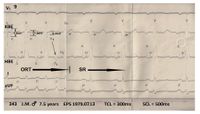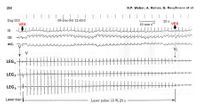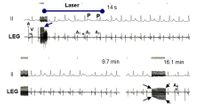Our methods
Our Unique Selling Position
1 The 1064nm Nd:YAG-laser light has a low absorption in water, scattering in tissue is intense, and it is selectively absorbed by the myocardium so that
2 myocardium is gradually heated up, however, the catheter itself is not. Thus, Nd:YAG laser ablation is achieved under normothermic conditions
3 Heating of the myocardium starts 2-4 mm deep intramurally and is spreading within a few seconds concentrically
4 A clear-cut homogenous lesion of coagulation necrosis is produced without tissue vaporization with crater formation, without the risk of perforation. The induced scar is not shrinking and there is no aneurysm formation
5 After epicardial laser application transmural lesions are achieved within seconds.
6 After endocardial laser application coagulated myocardium is visible through the normal translucent Endocardium (circle). The Lesion is homogenous, clear-cut, transmural
7 Epicardial laser application produces transcoronary lesions without thermal damage to the coronaries. Volumes of myocardial lesions produced depends on the coronary blood flow rate. Coronary vessel lumen is free from thrombi, intima and media layers are undamaged, however, a mild inflammation of the adventitia is present.
8 Laser light is not absorbed but highly scattered in the bright fibrous scar and is absorbed by the remnants of viable myocardium and ablating foci of VTs. Scars become arrhythmogenic without shrinking and without aneurysm formation.
9 The laser method is not arrhythmogenic or thrombogenic. In contrast to RF laser treatment does not increase D-Dimer Serum levels.
10 Regardless of myocardial wall thickness ≥20 mm after laser radiation at 15 Watts/ ≤ 60 ventricular lesions are allways transmural, and
11 simultaneously the local electrical potentials in the HD local mapping electrograms are abolished, Correlation Coefficient = 0.9.
12 Interelectrode distances of ≤ 2mm allow for high-density endocardial mapping (KBE) and localization of arrhythmogenic areas in the heart
13 Here dwindling of the specific AP (K) potential amplitudes during ORT and recurrence to sinus rhythm (SR) simultaneously with their abolishment of K potential (Ø) is shown.
Note: prerequisite for high-density endocardial mapping, for localization of arrhythmogenic structures in the heart, is a detailed and complete manual, robotic or by magnetic navigation guided electrode catheter exploration of the heart chambers, during continuous monitoring of electrical potentials.
14 With the laser start electrical potential amplitudes in the high-density mapping electrogram dwindle gradually.
With the laser stop the ventricular lesion is transmural (V1).
Simultaneously with the start and the stop of laser applications a ventricular extrasystole is induced (VES)
15 Laser applications at 15W aimed at the left atrial posterior wall can achieve transmural lesions in less then 5 s and ablation of chronic persistent long-lasting atrial fibrillation.
The laser method is a low power short duration – a low energy ablation method.
The electrophsiologically guided ablation allows for a systematic approach with simultaneous validation of initial success.
16 After the abolishment of local potential amplitudes in the high-density mapping electrograms ablation result is permanent.
However, if radiation is stopped prior to permanent potential abolishment, amplitudes will recover and the lesion produced is completely reversible.
This is shown here with an example of AV-nodal laser application.
Unmet medical technology based on key technology
The novel Laser Cathether Ablation System
The novel Laser Catheter Ablation System is an unmet medical device based on a key technology the laser. Unique selling positions of the open-irrigated Electrode-Laser Mapping and Ablation (ELMA) catheter System RytmoLas® are:
- It is an open-irrigated, non-contact method of transcatheter cardiovascular laser application.
- Inter-electrode distances of ≤ 2.0mm allow for High-density-mapping,
- thereby side-selective localization of arrhythmogenic substrates such as reentry pathways or arrhythmogenic foci is achieved.
- Ablation is performed under normothermic conditions while avoiding interfering with the electrophysiologic monitoring principles.
- Lesions are produced by selective absorbtion of the laser light in myocardium, the catheter itself is not heated up.
- Online monitoring of the abatement of electrical potential amplitudes during laser application represent an immediate and real-time verification of the succes of treatment.
- With the permanent abolishment of potential amplitudes laser lesions are transmural (correlation coefficient 0.9).
- Trasnsmural lesions are achieved regardless of position of the catheter upon the endocardial surface, perpendicular or flat.
- Transmural lesions can be achieved by Laser applications ad powers of 10-15 Watts within 5-30 seconds.
- The laser method is a Low Power - Short Duration (LPSD) ablation method.
- Lesions are achieved without pressure upon the endocardial surface, even without intimate catheter-endocardial contact.
- Homogenous distribution of the photon energy in myocardium produces clear-cut homogenous lesions of coagulation necrosis,
- without shrinking or aneurysm formation of the myocardial wall.
- Unhindered photon penetration through fibrouse tissue allows for ablation of remnand viable myocardium within scars.
- Premature stop of laser application, prior to the abolishment of potential amplitudes, results in transitory reversible lesions, and,
- potential amplitudes as well as histological tissue changes can recover completely within minutes.
- Laser lesions are not arrhythmogenic, are not thrombogenic, and do not jeopardize irradiated vessels.
- The laser catheter is MRI compatible.
The Unique Selling Position of the Laser Catheter Ablation System are published in peer reviewed scientific journals and book contributions.








